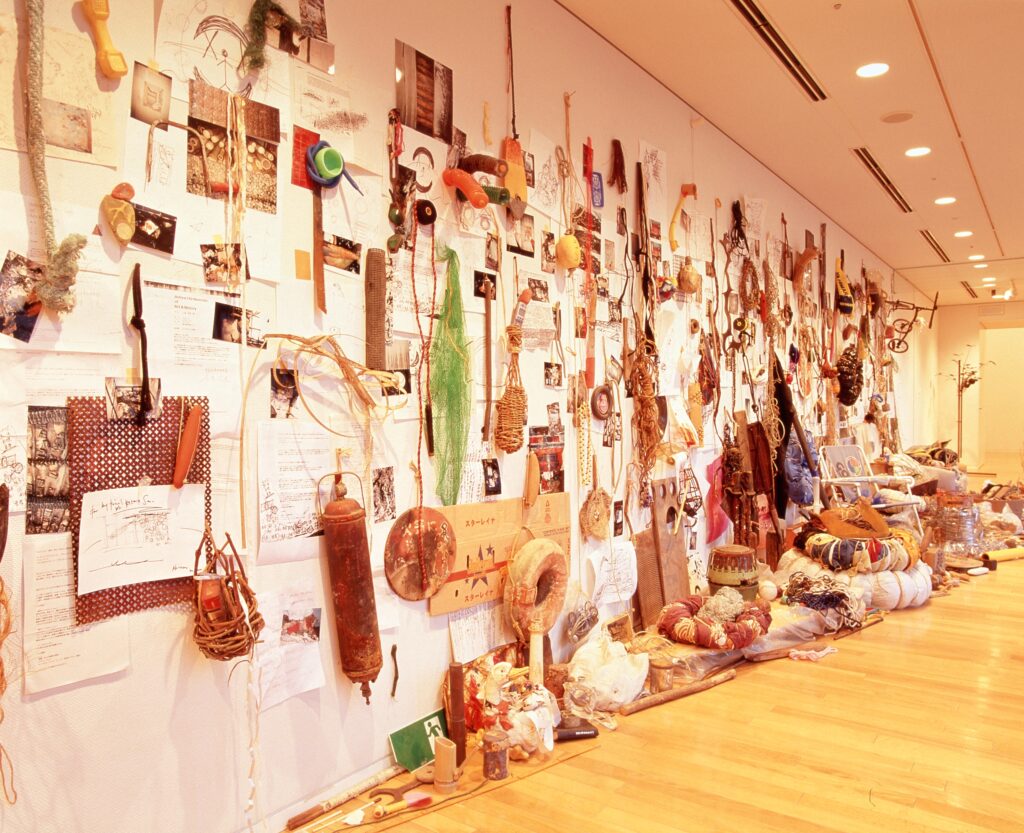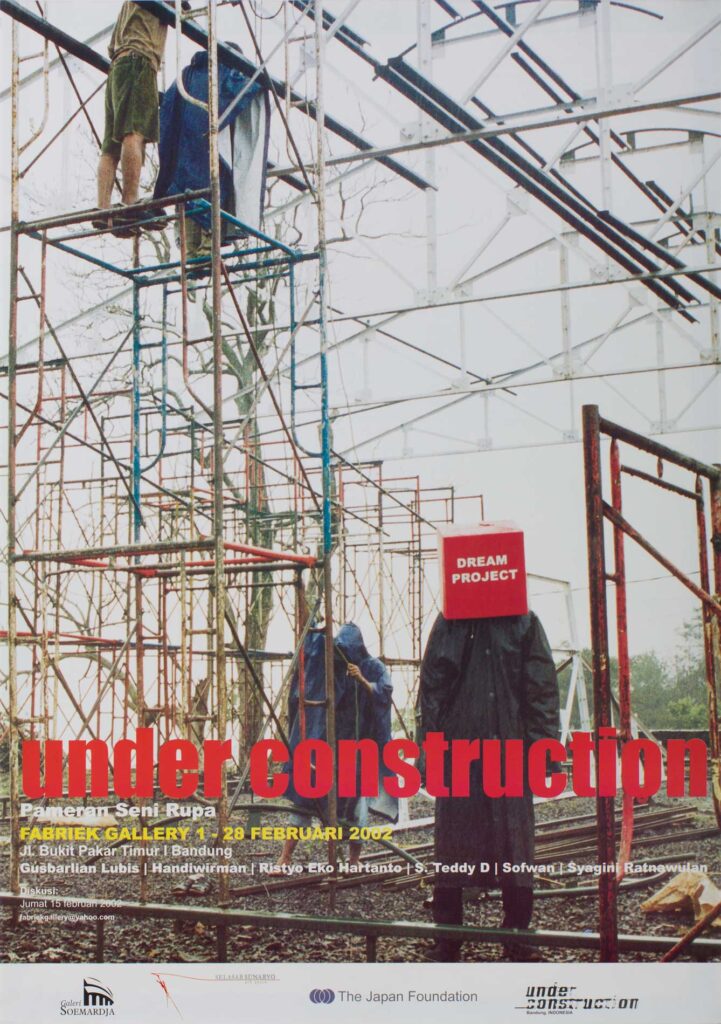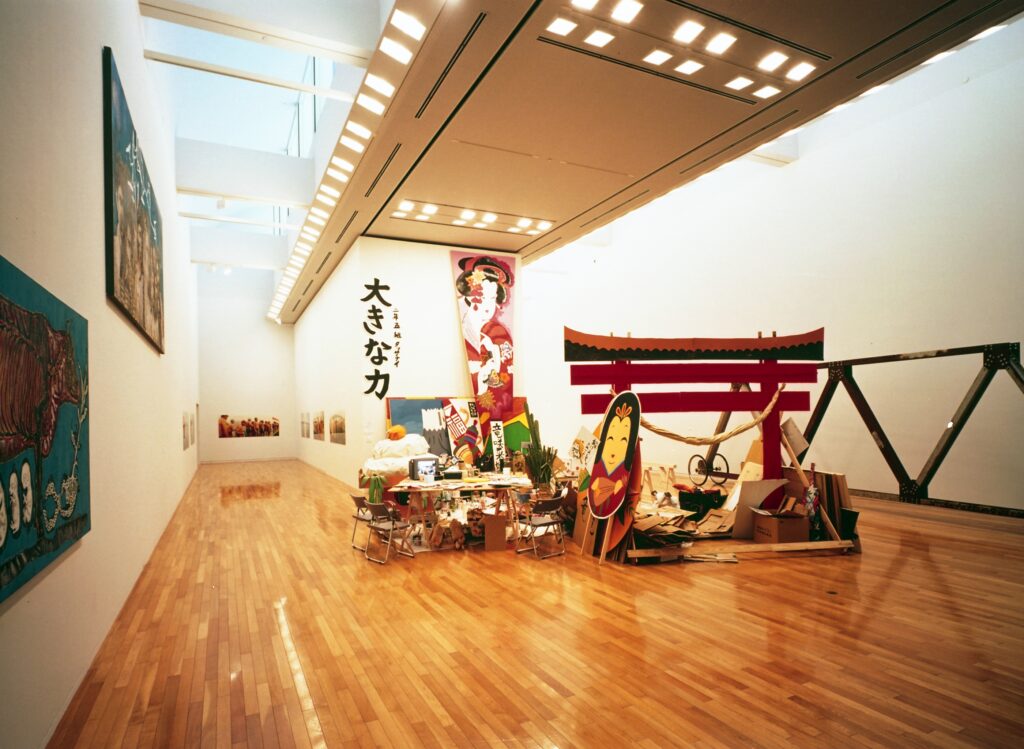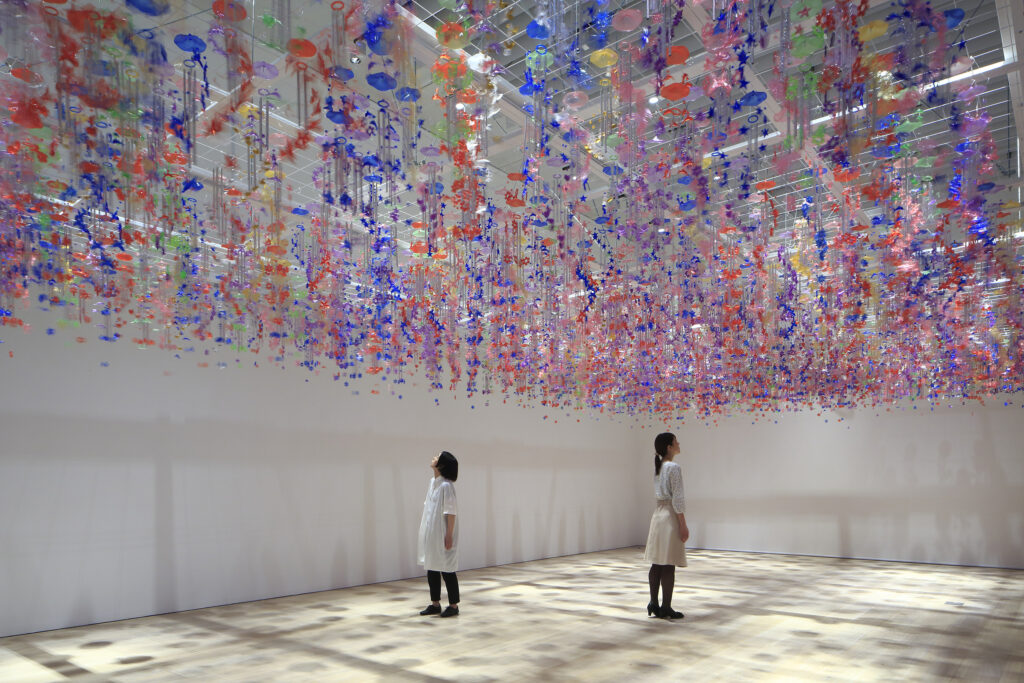2023.02.13
CULTUREHow to Define “Crossing the Curation Border”? Significance of International Collaboration in Art Exhibitions

Displays at the “Under Construction” collective exhibition held in 2002 (Tokyo Opera City Art Gallery). Alfredo Juan & Maria Isabel Aquilizan “Habitation project : Picking” Flotsam, bamboo, fallen leaves, videos, 2002. photo:KIOKU Keizo
There is great significance in the process involved in curating an exhibition because this process also fosters a deeper understanding and trust between artists and curators. Let’s look back on contemporary art exhibitions organized by the Japan Foundation to understand what international collaboration in the art field entails.
One particular exhibition acted as the starting point for the Asian art boom in Japan. It was “New Art from Southeast Asia 1992,” co-organized by the Japan Foundation (JF) and partner organizations including art museums from four cities in Japan. This was the first exhibition in Japan devoted to contemporary art from Southeast Asia with the aim to “cast a new perspective on the Western-oriented artistic outlook and the rigid view of Asian art” (an excerpt from the ‘Foreword’ of the exhibition catalogue).
One of the curators, USHIROSHOJI Masahiro, who worked at Fukuoka Art Museum at the time, reminisced about the exhibition in a journal published by the Society for the Study of Modern Asian Art in 2018. He said, “I believe I acquired a more methodological approach to research when I worked on “New Art from Southeast Asia 1992” as I partnered with the Japan Foundation and conducted research with NAKAMURA Hideki and TANI Arata. […] In addition, the time had come for society, or rather, the whole world, to turn its attention to non-Western art and art culture.”
Until then, most presentations on Asian art in Japan had focused on traditional aspects. The exhibition was organized as a means to help people learn about contemporary Asia, what problems artists in Southeast Asia faced during the region’s rapid economic growth and how their ideas are expressed. It was a major undertaking that involved introducing new works by 17 young artists from those in their 20s up to those in their 40s from all six ASEAN member countries (at the time). Not only did the exhibition leave a great impact on those who eventually became experts on Asian art, but the interaction among art professionals during the preparation process and their mutual interest in one another’s art scene has led to numerous art projects across Japan and Asia.

Poster of the Tokyo exhibition of “New Art from Southeast Asia 1992.” The exhibition was organized with the aim to cast a new perspective on the Western-oriented artistic outlook and the rigid view of Asian art. It was held in Tokyo, Fukuoka, Hiroshima, and Osaka. Design: Bijsutsu Shuppan Design Center
Three years after “New Art from Southeast Asia 1992,” “Asian Modernism” was held to explore the theme of what modernity means to Asia. Co-organized by JF and major museums in Southeast Asia, the exhibition began in Tokyo and toured the Philippines, Thailand, and Indonesia. Using examples from three countries with different historical and cultural backgrounds, the ambitious exhibition was designed to examine the history of the acceptance of modernism in various parts of Asia through modern and contemporary art and provide an overview of art history in Southeast Asia. In the exhibition, a new approach of cross-disciplinary curation was attempted for the first time in which each of the three Japanese curators took on a country for their research while working with local curators and area researchers who provided advice. It demonstrated the possibility of international collaboration in art.
The Perspective that Asks, “What Actually is Asia?”
In the early 2000s, a new generation of contemporary artists in Asia began to ask the question, “what actually is Asia?” Given this theme, JF planned an international collaborative project in the field of art called “Under Construction: New Dimensions of Asian Art” that ran from 2000 to 2003. The project involved young curators from seven Asian countries, and started off as local exhibitions held in each country, with a final collective exhibition later hosted in Tokyo.
Even though interest in Asian contemporary art had grown steadily in Japan since the hosting of exhibitions such as “New Art from Southeast Asia 1992” and “Asian Modernism,” internationally speaking, the positioning of Asian modern and contemporary art in art history and studies of its expression were still in the process of development. Despite individual connections among art professionals, there was a lack of an artistic platform and opportunities for information sharing and collaboration within Asia. On top of that, the art environment in each country was not all the same. The reality was that art talents of the same era were not quite organically connected. For “Under Construction,” nine curators in their 20s to 30s were invited from China, India, Indonesia, Japan, Korea, the Philippines and Thailand. Their involvement in the process, including field research, discussions, and deep dives into the theme leading up to the opening of the exhibition carried an important meaning.
One of the participating curators, KAMIYA Yukie, former gallery director of the Japan Society in New York, who was an independent curator at the time, recalls her experience as follows: “At the time, there were few opportunities for artists and curators in Asia to learn about each other’s respective countries. The process of ‘Under Construction’ was a unique opportunity for practice and exchange. As we shared discussions during the preparation process, we began to understand each other’s cultural background. JF further supported our sparked curiosity by giving us information and research opportunities on the art scene in each country. During field research, our co-curators guided us on visits to studios and art spaces, where we learned about the circumstances under which artists conduct their creative activities and discovered active local art scenes.”
Ms. Kamiya adds, “Through collaborative work, I felt a strong sense of reward from the results of discussions and negotiations that involved diverse thinking, which would not have been possible using my own perspective alone. The vibrant culture of Asia has attracted worldwide attention. There has been a dynamic movement within Asia to reexamine its historical perceptions and seek international dissemination. The name of the project, ‘Under Construction,’ reflects our awareness that we are in the midst of a work in progress, namely, the concept of contemporary Asian art.”

Poster from the local exhibition for “Under Construction” held in Bandung, Indonesia. The name of the exhibition was “Dream Project.”
Prof. Patrick D. Flores of the Department of Art Studies at the University of the Philippines Diliman, who also participated as curator, looked back on the experience as follows: “It was important because it invested in process, which takes time, care, and patience. The project was also very generous in giving the curators independence in developing ideas and projects; trying out various forms of interaction; and visiting different places for research. The project was vital in enhancing my professional career. It introduced me to the various aspects and phases of curatorial activity; enabled me to work with other curators; and trusted me to organize a large exhibition. At the time of the project, I was mainly doing art history and criticism, and not really curating. ‘Under Construction’ gave me the chance to seriously consider curatorial work.”
With regard to the activities of participating curators after the exhibition, Ms. Kamiya said, “Each of the curators is now active internationally, playing the role of disseminating the culture of their home country. At the time, we were exploring the methodology behind this, but now we are seeing steady results based on our experiences gained through the exhibition.” Following a stint as Chief Curator at Hiroshima City Museum of Contemporary Art, Ms. Kamiya herself served as Director of the Japan Society Gallery where she actively promoted art exchanges between the United States and Japan. Prof. Flores has gained international experience as a prominent historian of Filipino modern art, having served as Artistic Director of Singapore Biennale 2019 and Curator of the Taiwan Pavilion at the 2022 Venice Biennale.

Work exhibited at the “Under Construction” collective exhibition. Thasnai Sethaseree “Santa Claus is coming to town” Installation, workshop, 2002. photo:KIOKU Keizo
Importance of Sustaining Dialogue and Fostering the Next Generation
The cross-border curation seen through “Under Construction” developed into international co-curations involving different organizations. In 2005, the “Cubism in Asia: Unbounded Dialogues” exhibition organized by JF was co-hosted by the National Museum of Modern Art, Tokyo, the National Museum of Contemporary Art, Korea, and the Singapore Art Museum, making it a joint project involving multiple national museums. After its run at these three museums, the exhibition moved on to Maison de la Culture du Japon à Paris.
The key to the sustained development of the art world in Asia is simultaneously holding dialogue between artists, fostering the next generation and organizing highly creative exhibitions. Since the early 2000s, JF has hosted international symposiums, promoted art exchanges within Asia, developed the next generation of curators, and held contemporary art exhibitions in various locations across Asia. The major culmination of these efforts was the “SUNSHOWER: Contemporary Art from Southeast Asia 1980s to Now” exhibition held in 2017. Co-organized by the National Art Center, Tokyo, Mori Art Museum, and JF, the exhibition, which was held in Tokyo, was the largest-ever contemporary art exhibition covering Southeast Asia, with some 86 artists and groups participating. The planning for the exhibition began in 2014, with a total of 14 curators taking part until the exhibition officially opened. These curators conducted local research in 10 ASEAN countries and 16 major cities and they visited more than 400 locations including art spaces, art museums, and other types of museums. In the end, the exhibition attracted more than 350,000 visitors and garnered a great deal of attention.
The Asian art exchange program, run for many years by JF, is now taking flight around the world.

Felix Bacolor Stormy Weather 2009/2017 Wind chime Dimensions variable
Installation view: SUNSHOWER: Contemporary Art from Southeast Asia 1980s to Now, Mori Art Museum, 2017 Photo: Kioku Keizo Photo courtesy: Mori Art Museum, Tokyo
【Related pages】
International Collaborative Productions Generate Art through the Process of Working to Understand Different Cultures
Three Exhibitions Opening Up New Dimensions; Japanese Art and Architecture as Perceived by Overseas Curators
International Art Exhibitions in Venice and Yokohama Bring Together Art and its Aficionados from around the World
The Hub of Japanese Culture on the Banks of the Seine, Welcome to the Japan Cultural Institute in Paris
